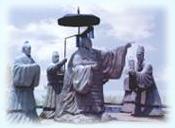|
 Back Back

|
|
Qin Shihuang

Imperial china begins with the founding of the Qin dynasty in 221 B.C.
(Qin, pronounced "chin," is the derivation of the English word
"China"). Although the Qin dynasty was short-lived, it set the
model for a unified and homogeneous state. The Han dynasty that followed
was one of the most stable and prosperous periods in Chinese history.
Several centuries of division followed the downfall of the Han, until
the country was united again under the Sui (A.D. 581-618) and Tang
dynasties (A.D. 618-906). King Zheng assumed the leadership of Qin in the year 246 B.C. at age
thirteen, and only a few years later launched a series of military
campaigns that led to the defeat of all rival states. He proclaimed
himself Qin Shi Huangdi (the First Emperor of Qin), initiating an
imperial dynasty that would rule over all the kingdoms of China. A new
capital was built at Xianyang, on the Wei River opposite present-day
Xi'an. Here, the First Emperor centralized control and formed a huge
court bureaucracy to administer the new empire. The country was divided
into thirty-six areas, each with its own governor. The emperor
standardized weights, measures, writing scripts, money, roads, and even
the axle widths of chariots. His most ambitious building projects
included work on the first Great Wall (meant to keep out foreign
invaders) and his own mausoleum, in which as many as 700,000 workers
toiled to supply a model army for his defense and a
model palace for his afterlife. The First Emperor is also remembered for
his fear of subversion, which led to the burning of books and harsh
treatment of scholars. His brutal regime and severe laws led to the
demise of the dynasty, which was toppled only three years into the reign
of his successor, his youngest son.
|
|
 |